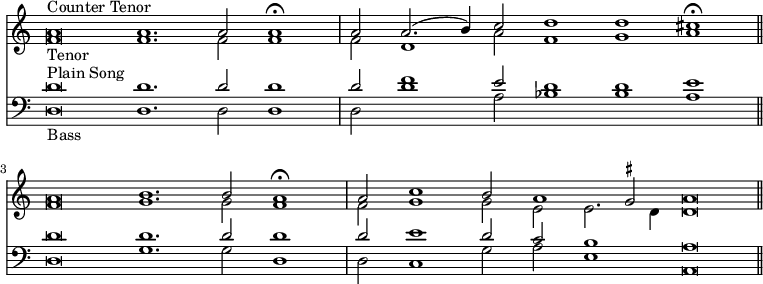as now, in four lines of eight and six alternately, but in two lines of fourteen, making a long rhyming couplet.[1] The verse, compared with other work of the same kind, is of average merit: the author was not, like Surrey or Wyat, a poet, but a scholar turned puritan preacher and printer, who pretended to nothing more than a translation as faithful as possible, considering the necessities of rhyme. But the most interesting thing in the book is the music, which here follows:—
Mode IX.
That man is happy[2] and blessed, that hath not gone a - stray:

Its interest is of several kinds. In the first place it is the earliest music to an English metrical version as yet discovered. It is also a double chant, a musical form hitherto supposed unknown till a hundred years later; and it thus shows by what a simple transition the passage from chanting the prose psalter to singing the metrical one might be accomplished. It would be unwise to argue from this single specimen that it was so accomplished, or that we see here the typical early English metrical psalm-tune; but certainly the discovery of this little composition, so obviously intermediate in character, very much diminishes the probability that anything like the chorale form, which soon afterwards prevailed, was known in England at this time.
We now enter upon the history of what afterwards became the authorized version. In the year 1548 or 1549—it is uncertain which, but possibly early in 1549—appeared a small volume with the following title:—
Certayne Psalmes chosen out of the Psalter of David and drawen into Englishe Metre by Thomas Sternhold, Grome of ye Kynges Maiesties Robes. London, Edvardus Whitchurche.'
This volume, which is without date, contains 19 psalms only, in the double common measure, or four lines of fourteen, by Sternhold alone, without music. Sternhold died in 1549, and on Dec. 14 of that year another edition was published, with a new title:—
All such psalmes of David as Thomas Sternehold late groome of ye Kinges Maiesties Robes didde in his lyfetime draw into English metre. Newly imprinted by Edward Whitchurche.
Besides the original 19, this edition contains 18 by Sternhold; and, printed as a second part, a supplement of 7 by J. Hopkins, without music. This is the volume which in previous accounts of the subject[3] has been usually described as the first edition; and no mention is made of Hopkins's supplement. It has also been usual to describe the contents as 'fifty-one psalms'; the actual number, it will be seen, is 44. Lowndes mentions a second edition of this work in the following year:—'by the widowe of Jhon Harrington, London, 1550.'
In this year also William Hunnis, a gentleman of the Chapel Royal, published a small selection of metrical psalms, in the style of Sternhold, with the following title:—
Certayne Psalms chosen out of the Psalter of David, and drawen furth into English Meter by William Hunnis, London, by the wydow of John Herforde, 1650.
A copy of this work is in the public library of Cambridge. There is no music. In 1553 appeared a third edition of the volume dated 1549, again published by Whitchurche. This edition contains a further supplement of 7 psalms, by Whittingham, thus raising the number to 51. There is still no music. Lowndes mentions another edition of the same year, 'by Thom. Kyngston and Henry Sutton, London.'
To this year also belongs a small volume containing 19 psalms in the common measure, which is seldom mentioned in accounts of the subject, but which is nevertheless of great interest, since it contains music in four parts. The title is as follows:—
Certayne Psalmes select out of the Psalter of David, and drawen into Englyshe Metre, with notes to every Psalme in iiij parts to Synge, by F. S. Imprinted at London by Wyllyam Seres, at the Sygne of the Hedge Hogge, 1553.[4]
In the dedication, to Lord Russell, the author gives his full name, Francys Seagar. The music is so arranged that all the four voices may sing at once from the same book: the parts are separate, each with its own copy of words; the two higher voices upon the left-hand page, the two lower upon the right; all, of course, turning the leaf together. Though the music continues throughout the book, the actual number of compositions is found to be only two, one being repeated twelve times, the other seven. The first is here given:—
- ↑ This was the usual way of printing the common measure in Crowley's day, and for many years afterwards.
- ↑ In the original the reciting note is divided into semibreves, one for each syllable.
- ↑ Except in that given by Warton, who speaks of several editions during Sternhold's lifetime; it is impossible however to corroborate this.
- ↑ The unique copy of this book is in the library of Emmanuel College, Cambridge. Thanks are due to the College for permission to examine it.
